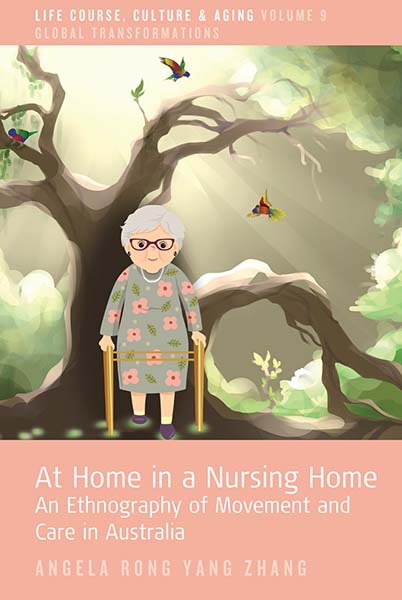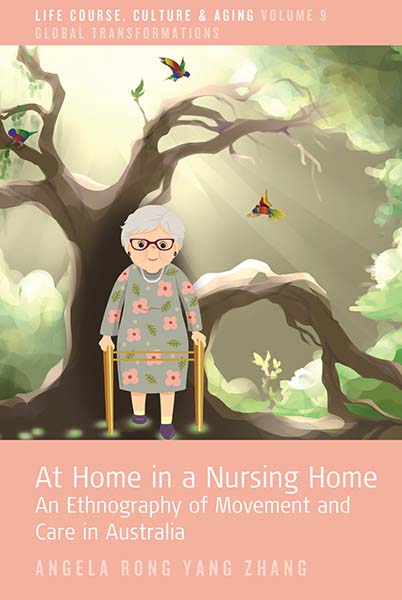
ANGELA RONG YANG ZHANG received the Australian Government Postgraduate Award and Emerging Researchers in Ageing Conference Bursary in 2015 and is currently Aged Care Research & Industry Innovation Australia (ARIIA) Grant supported researcher at College of Nursing and Health Sciences, Flinders University, Australia. Dr Zhang is also an Adjunct Fellow to School of Social Sciences at The University of Adelaide.
In this exclusive interview, Angela explores the inspiration and issues behind her new book, At Home in a Nursing Home: An Ethnography of Movement and Care in Australia.
Congratulations on the publication of At Home in a Nursing Home! Before we begin, would you please tell us something of your work to date?
My current research topic is about interpersonal understanding in and through care work. Here, interpersonal understanding is approached through the lens of empathy as empathetic understanding between nursing home residents and their formal and informal caregivers. In Australia, more than half of older people living in aged care homes have a diagnosis of dementia and experience communication impairments to certain degree. This has posed a challenge to the caregivers to know the changing needs and wishes of residents. The research outputs of this project includes an academic book and a staff training manual.
When did you begin work on your book and what inspired it?
This book is based on my nursing home project and 12 months fieldwork starting in 2015. I was inspired by a nursing home resident, who I called Mrs Joyce in the book, telling me that she felt at home in the nursing home. Mrs Joyce had difficulties with walking, and yet followed a daily walking routine. Although she relied on her walker and staff assistance for taking each step, she withstood the pain and made her own efforts to continue to walk. Mrs Joyce’s experience of feeling at home in the nursing home through assisted walking challenged my long-held assumption that nursing home residents could hardly feel “at home” – having a sense of control and connectedness in the world – while being subjected to the institutional practices that come to shape their everyday experiences.
In and through walking with nursing home residents and staff, I came to understand that while policies and practices may play a pivotal role in shaping and constraining how people could live and work in an institutional setting, they never determine how people could create a sense of home while being cared for.
How does the care system in Australia work? Is it private or state-run? And how well do you think it compares to those of other nations?
In the current aged care system in Australia, not-for-profit organisations (religious, charitable and community) operate 57% of residential aged care services across Australia while the ratios for private or government organisations are 34% and 8.6% respectively. Australian aged care services operate through a combination of government (federal, state, territory and local), non-government (charities, religious and community groups), and personal financial contributions.
In their Final Report of Royal Commission into Aged Care Quality and Safety (published in March 2021), the commissioners state that aged care services in Australia have systemic problems. Comparing with other nations such as Norway, Sweden and Switzerland, aged care system in Australia is significantly underfunded.
In what ways would you say that nursing homes have failed their residents in the past? Why do you think these problems have persisted?
At the core of the systemic failure are issues of inadequate government funding and ineffective governance. Under the accumulative pressure of budget deficit, residential aged care in Australia has been seen as a financial burden to the Commonwealth Government in Australia. The government-customer co-contribution funding model launched as part of the 2012 aged care reform accelerated the process to transform this once heavily government-subsidised sector into a profitable service industry. This policy shift was the government response to the question of “who pays for elder care” as well as that of “who is responsible for the quality of care”. Older people and their families become customers, and in accord with a neoliberal policy agenda, they are responsible for making choices about what they want and how much they will pay to receive it. In so doing, the government effectively transferred its responsibility for senior Australians receiving residential aged care to older people themselves, their families, and service providers.
Nevertheless, operating primarily on government funding, the aged care sector is by design a market-led for-profit industry, which functions to make money from older people and their families. Providers deliver what is paid for, not what is needed by residents, which has led residents and those who care for them structurally vulnerable to inadequate care due to the tension between care needs and care provision. This structural weakness has been exacerbated by COVID-19 when additional resources were required to keep residents and staff safe during the pandemic.
Residents can present a range of conditions, from mobility problems to a lack of mental capacity. Can any single care home give adequate care across such a wide spectrum?
The answer is no. Experiencing a wide range of impairments, residents need to have comprehensive and integrated health and social care to holistically support them to continue living a life in ways that they wish and desire, despite their impairments. Based on a good understanding of the resident’s conditions, needs and preferences, different aspects of health and social care, including medical, allied health, psychological, cultural and spiritual, need to be organically incorporated into the daily care provision. It thus becomes pivotal that aged care residents have access to health and care services provided in other sectors such as the primary care or allied health. In Australia, for example, the aspects of mental health and dental care need to be further integrated into daily care provision in residential care facilities. To do this, adequate financial, material, technological and human resources are crucial.
What are the first steps that would you take to improve care and what is the very best that residential care can achieve?
I believe that the very best that residential aged care can achieve is to enable older people to live a good life before they die, in ways that they wish and desire. I consider that, to make this possible, in Australia or other places, two aspects are central: first is to have access to sufficient resources in terms of funding, policy, workforce, technology, knowledges and skills; second is to utilise these resources to organise more person-centred care delivery to meet the needs, preferences and wishes of each individual older person.
The first steps that I would take are to develop effective tools through which the needs and preferences of each individual resident, including those who experience communication impairments due to dementia, can be identified and integrated into the care needs assessment and care planning system. In doing so, with limited resources that are currently available in the residential aged care sector in Australia, residents would have better chance of receiving person-centred care.
Who do you think will benefit most from reading your book? And which courses would find it a useful reading list addition?
For people who are trying to approach aged care service provision from an alternative perspective, namely, the bodily and lived reality, this book can be interesting and beneficial.
For academics and students who are interested in the phenomenologically oriented anthropological research on ageing, institution, health and care, this book can serve as an example.
I can see it being listed as essential purchase in first year anthropology as I think it would work really well to take something topical and demonstrate to students how anthropologists might reframe questions that are usually treated well within the common-sense parameters of social care services. It would also be of use to upper-level students as essential or supplementary reading, for quite a few courses, e.g. in anthropology, gerontology, gerontological nursing, aged mental health, dementia care, social policy, social care, etc.
And finally, can we ask what you are working on now?
I will continue my research on aged care in 2023 by taking up an Aged Care Research & Industry Innovation Australia (ARIIA) Grant supported position at the College of Nursing and Health Sciences at Flinders University, South Australia. I will join a multi-disciplinary team working on a project that investigates the effectiveness of iSupport training programme, which was originally developed by the World Health Organisation to optimising support for family carers of people with dementia. With strong interests in the social studies of health and care, I will continue my involvements with the School of Social Sciences at The University of Adelaide as an Adjunct Fellow.
At Home in a Nursing Home is published in our Life Course, Culture and Aging: Global Transformations series.

AT HOME IN A NURSING HOME: An Ethnography of Movement and Care in Australia
218pp, 14 illus.;
$135/£99 hardback
$34.95/£27.95 ebook
For the latest news on our books and journals please sign up for our email newsletters.
